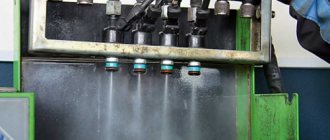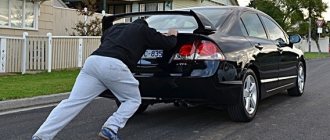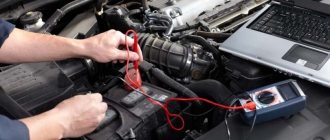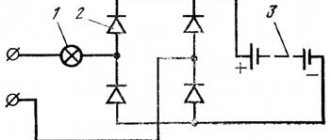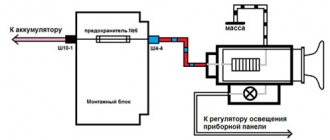Autobuffers - save money on suspension repairs, increase ground clearance +3 cm, quick and easy installation...
Official website >>>
Car owners must monitor the condition of their vehicles so that their operation is as safe as possible. A very common problem with cars is the steering wheel pulling to the side when driving, accelerating and braking. Today we will talk about the causes of such malfunctions and the rules for eliminating them.
Displacement of the rear wheels relative to the body
A change in the geometric parameters of the body is a fairly rare reason. However, because of it, when accelerating and braking, the car pulls to the left or to the right.
Everything is very banal - the reason is not in the body changes, but in incorrectly performed work to adjust the position of the front pair of wheels relative to the rear. If you set everything up correctly, then there will be no problems.
Why does the car pull to the left or right when you let go of the steering wheel?
It is not uncommon for drivers to encounter the fact that the car does not want to go in a straight line if it is not constantly monitored. If you let go of the steering wheel for a second, the car begins to be pulled to the left or right from the trajectory that was before.
If you are faced with a similar problem, then this article should help you. Here we will look at the main reasons that can lead to such behavior of the car, and also talk about how this can be corrected.
First, let's list the main reasons why a car may pull to the left or right when the driver lets go of the steering wheel.
- tire problems;
- incorrectly installed directional wheels;
- wear of steering tips or breakage of steering rods;
- wheel bearing wear;
- broken wheel alignment;
And so, let's start, as expected, with what you can check and fix with your own hands. Namely, from the tires. To diagnose this problem, you need to swap the wheels. Place the front ones back and the rear ones forward. If the situation has improved, you should put a spare tire on the side in which the car is heading. If the problem goes away, then all that remains is to change one wheel to working tires.
If you have directional wheels, make sure the arrows on them point in the correct direction. If the direction is correct, then it is necessary to check the wheel alignment. Alas, to do this you will have to go to a service station, since a similar procedure is not carried out in a regular garage. Often, it is violations of the correct camber and toe angles that cause the car to become obstinate on the road. In addition, the stability of the car decreases, tire wear increases and other unpleasant phenomena may appear. If everything is in order with this parameter, then the reasons should be looked deeper.
Worn steering tips or broken steering rods can also cause the car to pull to the right or left while driving. In principle, you can check these elements in your own garage, especially if it is equipped with an inspection pit. But if you don’t know how to determine steering system malfunctions for sure, it’s better to contact specialists, especially since you’re also unlikely to be able to replace them yourself. Therefore, contact a professional to diagnose your steering system.
Malfunctions in the hub, especially wear of the wheel bearing, can just as easily cause the car to spontaneously drift away from the correct trajectory. The actual wear of the wheel bearing can be clearly heard by characteristic knocking, crunching and grinding sounds in the area of the wheel on which the wheel bearing has worn out. As a result of such wear, the smooth rotation of the wheel is significantly impaired. Which cannot but affect the trajectory of the car. The wheel bearing should be changed not just in a repair shop, but in a repair shop whose quality of work you completely trust. This is not an easy task and the slightest mistakes can cause very rapid wear of the wheel bearing. Therefore, it should be changed by a truly conscientious and experienced specialist.
Damaged tire
This is already a more significant reason. Tires tend to wear out only partially. Therefore, the stability of the movement of the steered wheels may be lost. It is necessary to carefully check the condition of all tires. If it is not possible to replace damaged rubber, you can turn them over with the smoother side out. This is a way to restore driving stability to the car, and also save on replacing tires. But you need to remember that this can only help for a short time. The tires will still have to be changed.
The car only pulls when braking
We looked at several reasons why a car wanders off a straight line. This manifests itself in all cases - when moving, accelerating and decreasing speed. We need to dwell on the last characteristic in more detail.
Experts say that if the car pulls to the left when braking, then the culprit is the brake pads that are stuck on the drum or disc. Diagnosis in this case is very simple. It is enough to drive the car for about 10-15 minutes, periodically trying to brake lightly. Then they stop and check the disks for heating. If they are excessively hot, the problem is definitely in the pads. They are stuck in the brake caliper. Sometimes the problem is accompanied by a characteristic burning smell.
This malfunction can only be observed on one side. It is also worth checking the pads for even wear. How does this affect our situation? If there is uneven wear, then when braking the car pulls to the left or to the right (depending on the wear). The problem can be solved by sharpening or replacing the discs.
What to do if you notice your car is pulling to the side
Car diagnostics, carried out on time and correctly, will make it possible to find the reasons why the car pulls to the side. An experienced and knowledgeable specialist, with technical documentation and the necessary equipment, will definitely find the cause and help eliminate it.
The driver of the car must monitor the proper operation of all systems of the car in order to minimize the risk of a traffic accident due to the failure of one of them
For travel safety, special attention must be paid to the braking system and steering. If there is the slightest sign of a malfunction, you need to immediately diagnose and fix the problem.
A typical problem that all drivers have to face when using a car for a long time is the spontaneous tendency of the steering wheel to turn to the side, thereby deviating the car from the chosen course. If the steering wheel pulls to the right or left, there could be many reasons for this. Within the framework of this article, we will look at what is causing the problem and why the steering wheel pulls when braking or accelerating.
VAZ-2107 and brake system
If the car pulls to the side when you press the pedal, then, as described above, the problem lies with the car. It is recommended to check how well the rear pads are adjusted.
When the car pulls to the left when braking (including the VAZ-2107 injector), most likely, when replacing the pads, they were not completely changed. Due to uneven wear on one of the wheel sets, different resistance occurs when you press the pedal. The pads on the drums are changed in pairs, on both axes. It is also a good idea to check the condition of the drums themselves. Over time, various types of damage can form on their surface:
- Risks.
- Scratches.
- Badasses.
If oils or other oil-containing liquids get on the working surface (or pads), then this is another reason why the car pulls to the left when braking. It is recommended to check how well the elements are secured in the front suspension of the car. At the same time, check the fastening of the calipers on the front brakes.
If the pistons in the brake cylinders are heavily worn, this can lead to scratches. As a result, the piston will jam. Finally, failure is possible (colloquially “sorcerer”).
VAZ 2107 pulls to the right when braking
VAZ 2107 pulls to the right when braking
In the section Service, Maintenance, Tuning to the question people VAZ 2107 such a problem when pressing the brake the car strongly leads to the right what the hell is asked by the author Bloodsucking the best answer is Uneven wear of the brake pads and ball joints.
Reply from
22 replies [guru]
Hello! Here is a selection of topics with answers to your question: people VAZ 2107 such a problem when you press the brake the car pulls too hard to the right what the hell
Answer from Denis Galiev [newbie] either wheel alignment needs to be done or the wheels are clumsy (the wheels are overloaded)
Answer from Prosyp [guru] The front brake cylinder is jammed. One of the wheels should become noticeably hot. Don’t delay repairs - the brakes will boil and everything will end badly.
Answer from Alex [guru] Most likely ball joints
Answer from chevron [master] caliper sticks
Answer from Kolyok Dyachenko [guru] if it pulls to the right when braking, it means hemorrhoids on the left, in general, change the pads, check the brake hoses, refill the brakes, bleed the brakes, 7 is like a children's construction set, everything is simple there))
Answer from Vladimir [active] This is because only the wheels on the right side brake!
Answer from Sores from the people [guru] to begin with, I would pump the system... (you need 2 people) if there is a lot of air (since the car is driving) you take a bottle of brake fluid, a hose like from a dropper - put it on the fitting and go from the rear right wheel... (in short, look at the distance of the pipes)... will not help - see if the brakes work at all on the side opposite to the skid... oh Lada... PS - it’s logical, first I’d look to see if the pads move at all
Answer from IGOR KUSTOV [guru] On the left side, the pistons of the brake cylinders are soured due to torn rubber covers.
Answer from Dima Zadolin [guru] Uneven distribution of force during braking. The right side grabs before the left. When the asphalt is dry it’s not scary, but in wet weather and ice it’s very dangerous. Balls have nothing to do with it. The brakes need to be bled - apparently there is air on the left side. Look at the trim from the front. Perhaps the left outer one is worn to zero. In general, try to buy a car with ABS and ESP. Good luck.
Answer from Qwertyupp qwertyupp [active] Only the right wheel brakes, so it pulls to the right. The reason is the wedge of the calipers on the left due to corrosion.
Answer from Rubik [active] Change the pads! Miscellaneous wear!
Answer from Anton Serdyukov [active] incorrect operation of the brake system: the right brakes the left no
Answer from Yaim Usmanov [active] Check the pads: condition, moving, no. If ok, bleed the system.
Reply from
2 replies [guru]
Hello! Here are more topics with the answers you need:
Pulls to the side when accelerating
If the car is front-wheel drive, and additional spacers are installed on the springs, then it will move away from a straight course. In which direction it will be directed depends on which side the thicker spacer is installed on. In this case, two axle shafts operate at different angles. Due to different centrifugal forces, the car is pulled to the side when moving.
This problem happens often on front-wheel drive VAZ cars. But this can be eliminated by self-adjustment. If the car pulls to the left when braking (VAZ-2109, for example), it is enough to remove the adjusting washers from under the rack on one side and install them on the opposite side. The pedal response should stabilize.
About the need for regular diagnostics and maintenance
To prevent such malfunctions and work to eliminate them from turning into monthly procedures, it is necessary not to neglect scheduled maintenance and timely diagnostics of the brake system and vehicle suspension. Regularly clean the brake system of dirt.
Diagnostics will allow you to avoid many problems not only in the brake system and suspension. If you periodically inspect your car, you can promptly remove jammed pads, adjust wheel alignment, and equalize tire pressure. And then the car will no longer move to the side, and driving will become much safer and more comfortable.
Is the car being pulled to the side? Let us explore the possible reasons for this “deviation”.
Even an inexperienced driver will quickly feel something is wrong when his car suddenly starts to pull to the side on a flat road. It is enough to let go of the steering wheel for a couple of seconds - and the car rushes into a ditch, in which, of course, there is nothing good. What is the reason for this “right-wing deviation”? There can be quite a lot of them - we easily collected a dozen. See our photo selection below...
Current Auto News
Slope of the road.
Roads are built in such a way that the cross-section of the pavement is convex. This prevents water from accumulating on the roadway. Thus, driving on the right side of the road, we will always feel a slight tendency of the car to go to the right. Of course, on federal highways the effect is almost unnoticeable, but on secondary roads the profile is sometimes such that you constantly have to adjust the trajectory with the steering wheel. If you find a “right bias” in just such a situation, then you don’t have to worry - the car is in good condition, the problem is on the road.
Incorrectly placed load.
If, when the car is thoroughly loaded, one of its sides gets more than the other, then the answer lies on the surface. When you free yourself from the burden, the effect will disappear by itself.
Side wind.
This seemingly frivolous reason manifests itself in a very powerful way in practice. Sitting in a closed cabin, passengers rarely think about the wind, but the driver feels its breath constantly. It is no coincidence that the wind has received a separate road sign!
The pressure jumps.
This does not mean the driver's blood pressure, but the difference between the pressure in the right and left tires. If it exceeds at least 0.2 kg/cm², then the car will begin to pull towards the lowered wheels. A flat tire has greater elasticity, an increased contact surface with the road surface and, therefore, a greater coefficient of friction. Treatment is simple: adjust tire pressure.
In particular, the outer edges of the tread usually wear out at the front. The treadmill of the wheel takes the form of a truncated cone. In normal driving mode, these two cones (right and left wheels) create multidirectional forces that cancel each other out. Now imagine that you punctured your left front tire and went to a tire shop. There the wheel was repaired and, for good reasons, placed with the less worn edge outward. And what's the result? Both cones are now trying to roll you to the side. The same effect can be observed in a more harmless situation: having punctured a tire, you replaced it with a spare tire, which had never seen the asphalt before. The difference in wheel diameters on one axle will instantly make itself felt.
Wheel alignment angles.
They need to be checked periodically. This is especially important after you accidentally hit a serious pothole on the road. It happens, however, that the car begins to pull to the side just after adjustment by an unscrupulous technician. He set the angles correctly, but did not check the geometry of the entire suspension.
Body geometry.
If the geometry of the body or suspension is broken, the car will pull to the side. Back in the days when Volgas and Muscovites used springs in their rear suspension design, you could see cars on the road moving a little like a crab, sideways. This was caused by loosening of the rear axle beam fastening to one of the springs. The bridge was tilting and the car was moving slightly at an angle. When the driver turned the steering wheel, a driving force acted on the car. In modern times, springs are rare, but many crappy roads remain. They can easily damage complex multi-link suspensions. As a result, the car pulls to the side.
Current Auto News
Elasticity and rigidity.
In practice, elastic suspension elements (springs, torsion bars or pneumatic elements) on the right and left sides of the car may have different rigidities. At the same time, the body acquires a constant slope, which contributes to the car’s drift.
Power steering.
It happens that the power steering starts to play havoc. Remember the story with the Lada Kalina’s electric power steering, when some owners’ steering wheel began to turn spontaneously? But the hydraulic booster can also give the same effect if certain parts break down.
Brakes.
If the car pulls to the side when braking, then most likely the brake on the opposite side has failed. In other words, if the car pulls to the right, then the left brake is fooling - and vice versa. Also, the car pulls to the side when the rear wheels brake more actively than the front wheels, and as a result, a skid occurs, which is especially dangerous in winter on slippery roads. Therefore, at the slightest suspicion of faulty brakes, you need to go for diagnostics so that servicemen check: the presence of brake fluid in the system, the tightness of the brake hoses and pipes.
Control bodies.
In a modern car, the causes of right or left “deviation” can be any errors or failure of electronic assistants responsible for the operation of one or different systems, monitoring and control subsystems of the car. Which ones? Well, off the top of my head: ABS, ESP, BAS, EBS. Such a malfunction is usually indicated by a pictogram that lights up on the devices.
Front-wheel drive.
By the way, the pull of a front-wheel drive car to the side can be explained by different lengths of the axle shafts. The reason is the layout of the power unit. It is not easy to place the gearbox in the engine compartment at an equal distance from the wheels so that the length of the axle shafts is the same. As a result, some slip appears during acceleration. There is no need to worry about this, since it is not a malfunction.
You can recall a dozen more exotic reasons that give rise to “deviation” - a seizing wheel bearing, a seizing caliper, etc.
Answers@Mail.Ru: If the steering wheel shakes and the car pulls to the right
1. if the steering wheel shakes when you press the brake pedal, you need to replace the brake discs. 2. If the steering wheel shakes all the time, it means that the wheels need to be balanced at a tire shop. 3. if the steering wheel pulls to the right, check the air pressure in the right wheel, if the pressure is normal, then at one hundred for inspection, it is possible to first repair the suspension and then the wheel alignment
besides this there are spars and a bunch of other reasons
Yes, you need to check the wheel alignment and balancing if the steering wheel shakes.
1. For diagnostics of the steering rack 2. Change tires
Wheel balancing and wheel alignment - that's all
The most likely cause is a crooked wheel. To check, swap the front wheels. Next is brake malfunction. Collapse? May be. It can pull to the right because of it, but it doesn’t give any beating. Incorrect alignment and malfunctions of the steering rack cannot manifest themselves in this way.
When braking, my steering wheel starts to shake (slightly), I found out that it’s the upper supports of the front struts—it needs to be changed.
touch.otvet.mail.ru
